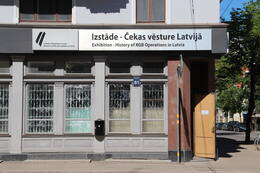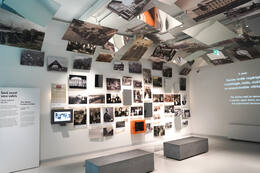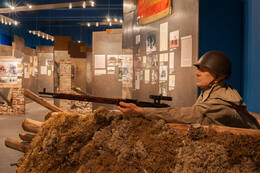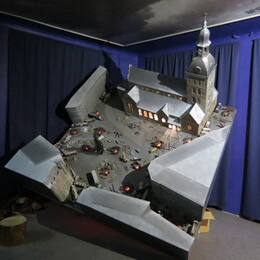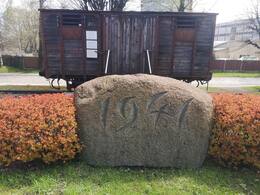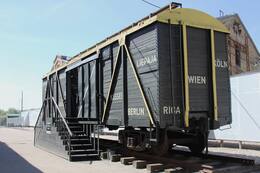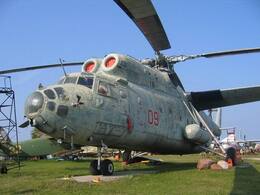Military heritage along the Iron Curtain Route by car from Tallinn to Liepāja
Day 5.
1 km
A day in Rīga
Practical info
- Tickets for the KGB building tour in Rīga can be bought in advance. Excursion times and tickets www.bezrindas.lv. More information: +371 27875692. Not recommended for children under 12.
- Opening times for the Museum of the Occupation of Latvia okupacijasmuzejs.lv.
- The tour can be prolonged by spending a day in Rīga to visit military heritage sites such as Bother’s Cemetery and the Memorial to Žanis Lipke.
Sights
Exhibition in the KGB Building "History of KGB Operations in Latvia"
The former USSR State Security Committee (commonly known as Cheka) building is open for visitors. Here chekists imprisoned, interrogated and murdered Latvian citizens who were considered opponents by the occupation regime. There is also an exhibit from the Latvian Occupation Museum on the activities of Cheka in Latvia. Guided tours of the prison cells, corridors, basement and courtyard are available. The house was built in 1911 and it is one of the most beautiful buildings in Riga. Called the ‘Corner House’ by the people, it was the scariest symbol of the Soviet occupation regime in Latvia, and also one of the pillars of power of the USSR. Cheka operated from the Corner House during the occupation from 1940 to 1941 and then again from 1945 to 1991. Tens of thousands of Latvians were affected by direct political persecution. The fight against enemies of Soviet rule continued also after World War II. Cheka’s approach towards its operation slightly changed after Stalin’s death. Physical torture was replaced by psychological terror. The majority of Cheka agents were Latvians (52%). Russians were the second largest group – 23.7%. 60.3% of the agents were not members of the Communist Party. 26.9% of the agents had higher education. The system was designed in a way to involve local people and thus have greater control over the society. Staff documents and service records are located in Russia. And these materials have not been made available to Latvian authorities and researchers.
Museum of the Occupation of Latvia
The museum exhibits the history of Latvia from 1940 to 1991, under the occupation of Nazi Germany and the Soviet Union. ‘House of the Future’ is a reconstruction and expansion project of the Occupation Museum designed by the well-known American Latvian architect Gunārs Birkerts as well as the new exhibit of the museum. The exhibit ‘History of Cheka in Latvia’ was created by the Occupation Museum and it is located in the ‘Corner House’, which is the former USSR State Security Committee (KGB) building. Latvian Occupation Museum was founded in 1993. It tells the long-hidden story of the fate of the Latvian state, nation and land under the occupation of two foreign totalitarian powers from 1940 to 1991. At the end of 2020 the museum had more than 70,000 different historical items (documents, photographs, written, oral and material evidence, objects and memorabilia). Museum specialists have recorded more than 2,400 video testimonials, making it one of the largest collections on occupation in Europe. The events that unfolded in Latvia, Lithuania and Estonia clearly show us what the nations had to endure under the two totalitarian regimes.
Latvian War Museum
The Latvian War Museum is located in the Old Town not far from the Freedom Monument in a historic defence building called the ‘Powder Tower’. There are 11 exhibits in the museum. There are various weapons, documents, uniforms, awards, badges and other items detailing the everyday life of a soldier in war. The Latvian War Museum is one of the oldest museums in Latvia. Its origins can be found in World War I. Museum’s collection was made up mainly of personal items of soldiers or items found on battlefields. After Latvia gained its independence the main goal of the museum became to create an exposition on the military history of Latvia and the active role of the population in protecting their land. In 1937 the museum was expanded and was technically one of the most modern museums in Europe at that time. The Powder Tower was one of the fortification towers of Riga. Some evidence dates back to 1330 where it has been mentioned as the ‘Sand Tower’. The tower was destroyed in 1621 when Riga was besieged by the Swedish Army. But in 1650 a new tower for storing gunpowder and weapons was built. After the city’s fortifications were taken down, the Powder Tower remains as one of the most important pieces of evidence of the Riga defence system.
1991 Barricades Museum
The museum is located in Old Riga near the Riga Cathedral. It was founded in 2001 to preserve historical evidence of the events of 1991 in Latvia. A virtual tour of the museum is also available. In January 1991, in Lithuania the Soviet Army opened fire on people who had gathered at the Vilnius TV tower and drove into the crowd with tanks. In response to these events a demonstration of about 500,000 people was organised in Riga to show support to Lithuanians and the readiness of the Latvian people to continue their struggles towards Latvia’s independence. In order to prevent similar events from happening in Latvia, residents began to build barricades in the narrow streets of Old Riga in order to prevent possible attacks of the Soviet Army on the defenders of the barricades. These barricades were also created at various strategic objects not only in Riga, but throughout all of Latvia. Around 50,000 people from all over Latvia participated in defending the barricades. Barricades was a popular movement that helped to regain Latvia’s independence. This is a great example of non-violent resistance in the history of the whole world.
Victims of Communist Terror Memorial in Torņakalns
The memorial site is located in the Torņakalns railway station in Riga. It is dedicated to those deported in June 1941. Initially it was planned to create a memorial in Esplanāde park, but later it was decided to place it at the Torņakalns station. The memorial consists of five torn stone sculptures symbolising the ruined families and three generations of deportees. The sculptor of this memorial is Pauls Jaunzems and the architect is Juris Poga. It was unveiled on 14 June 2001 by the then President of Latvia, Vaira Vīķe-Freiberga. Next to the station there is a freight waggon and a commemorative stone dedicated to the deported Latvians. The commemorative stone with the inscription “1941” is a 1.2 m high crude boulder. The author of the memorial stand is the sculptor Ojārs Feldbergs.
Riga Ghetto and Latvian Holocaust Museum
The Riga Ghetto and the Latvian Holocaust Museum is located in Riga close to the Riga Central Market and the Riga Central Station. The museum was opened in 2010 on the site where the city's warehouses once were. It is located in the historical part of the city, next to the border of the former Jewish ghetto. The territory of the ghetto is unique, because in terms of architecture it has not changed since World War II. It is a memorial dedicated to the tragedy suffered by the Jewish people. The German policy regarding the Jewish population in Latvia until the end of 1939 was for the German diplomats and politicians to try and pressure the Latvian government to take action against the Jews by restricting their freedom. After the emigration of the Baltic Germans in 1939, the German embassy no longer had as good an access to information on the mood of the population and the events happening in Latvia as before. When the Red Army occupied Latvia, they manipulated the society to gain some support of the Jewish population for the new occupying power. However, after the regime started a crackdown on the society as a whole, the support fell rapidly. As a result of all this, a deep divide had formed between the people. And later on, the next regime – Germany – tried to exploit it. They hoped that the local population would harass and attack the Jews, but that did not happen. So, Germany adjusted their approach and devised a new plan to initially establish a Jewish ghetto and later destroy its inhabitants.
Riga Airmuseum (Riga Aviation museum)
The Riga Air Museum is located in Skulte village, Marupe municipality, in the territory of Riga Airport, next to the aircraft observation area. It is a privately made tourist attraction that opened in 1997. It has taken more than 50 years to create this collection. Aviation equipment has been gathered from Latvia, Russia, Poland, Ukraine, the Czech Republic and the USA. It is one of the largest and most valuable collections in Europe. The idea of a Latvian Aviation Museum was conceived at least 80 years ago. The history of Latvian aviation dates back to the time when the world's first aircraft were being developed. Latvian pilots were among those who participated in achieving many world records. After World War I and the Latvian War of Independence the Latvian Army started to form an air force, and there was a need to preserve historical evidence. In the 1930s, there was an opportunity to start work on creating a museum. It already had acquired some particularly valuable historical items in its collection. World War II thwarted this project and the collection was lost. Nowadays there are about 40 aircraft objects, mainly manufactured in the Soviet Union. And the exposition gives an insight into the history of Soviet aviation.




